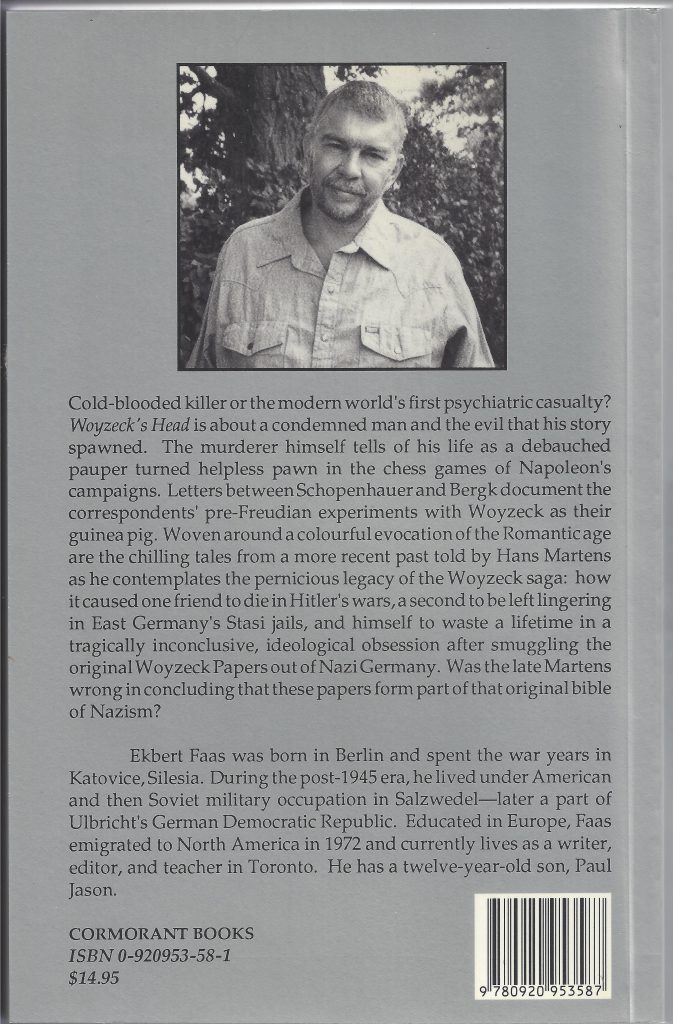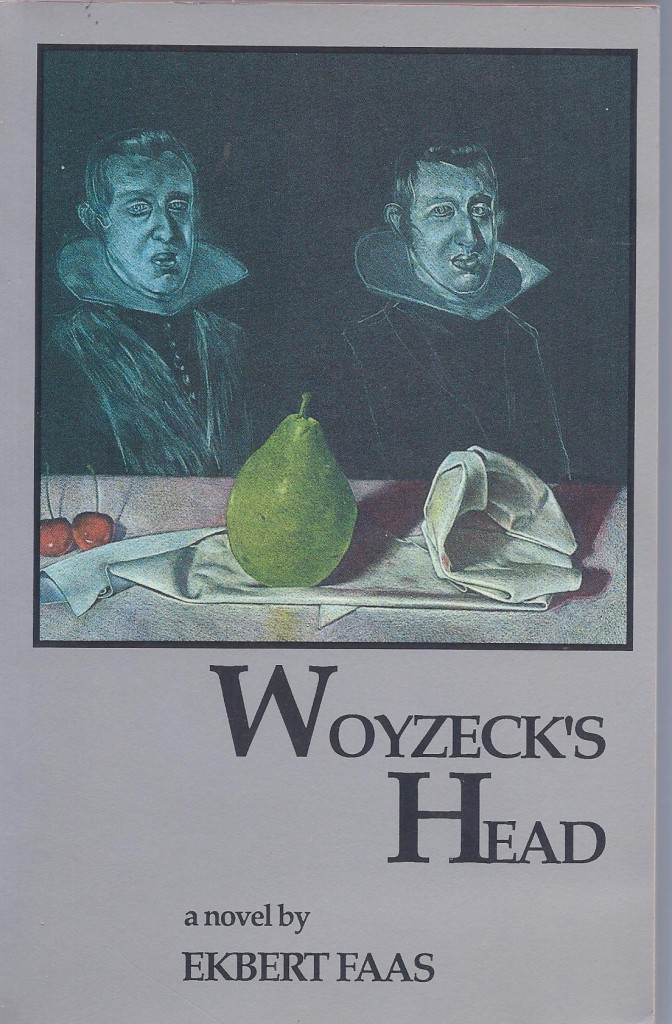
When Ekbert Faas’ novel, along with Douglas Copeland’s Generation X and Rohinton Mistry’s Such a Long Journey, was shortlisted for the Smith Books First Novel Award, Woyzeck’s Head was called the “most philosophically ambitious and dense of all the novels here. If it weren’t for the utterly persuasive and eerie portrayal of Woyzeck, ‘veteran’ of the Napoleonic Wars, murderer, and, ostensibly, the first modern psychiatric patient, one could call this a novel of ideas. Faas, however, dramatizes the ideas through incident and characters who emerge as real people – however distant and historical – engaged in scientific and moral speculation.” (Evaluator Kenneth Radu, Books in Canada, April 1992, 11-15),
Poet and novelist Michael Holmes called Woyzeck’s Head the “most important piece of Can. Lit. I’ve read in a long time;” former British Poet Laureate Ted Hughes found the novel “fascinating – really gripping. Full of the real diabolical glee. And so canny.” (Personal correspondence.)
“A maniacally masterful mind game disguised as a novel … The novel begins smack in the middle of an account by a young man named Hans Martens as he risks his life to smuggle ‘the Woyzeck Papers’ out of Nazi Germany. This singular cache contains the other two narratives that make up the whole, which opens as slowly and as tantalizingly as a Russian matryoshka doll.
“Faas’s Rosencrantz and/or Guildernstern is one Dr. Adam Bergk, an early 19th-century alienist, occultist, proto-Freudian and opponent of the death penalty. Bergk is a genuine historical figure, but is of no consequence in the Büchner play. In Woyzeck’s Head, he is the X at the centre of the game … The epistolary relationship between Bergk and Schopenauer forms the second of the three narratives. The third, as can be expected, is Woyzeck’s own. In the strangely lucid ramblings he produces at Bergk’s urging, he tells of the frightful religiosity of his childhood, his blood-chilling expriences as an unwilling soldier in the Napoleonic wars, his need and hatred of women, his dreams, his nightmares and his visions … Faas, writing in English, is mannerly toward his non-German audience. In fastidious footnotes, he provides translations of the German, French and Latin phrases that dot the text, as well as bibliographical information and explanations of allusions. But are the footnotes an academic nicety, or a wink from the author to encourage you into the game? By now the game should be obvious: is history fact or fiction? This ambitious, exhilarating novel is the most intellectual fun I’ve had since Julian Barnes’s Flaubert’s Parrot. It operates on so many levels: literary, historical and philosophical.” (Eve Drobot, Globe and Mail, 1991/9/28)
“Since its beginnings the novel has always masqueraded as something else – memoir, biography or exchange of letters. In our own day, one of the cleverest disguises was adopted by Vladimir Nabokov whose novel, Pale Fire, is buried in pseudo-academic notes appended to an epic poem. Now … Faas has cast his novel, Woyzeck’s Head, in the form of newly-discovered documents relating to the celebrated case of Johann Woyzeck, the subject of Büchner’s famous play, later turned into an opera by Alban Berg … In literary jargon, this is called a post-modernist novel. Actually, it’s just a very good one … The pleasure afforded by following the play of ideas in this tale makes one hope it won’t be his last.” (H. Werner, Toronto Star, 1991/11/16)
“Reminiscent of Grimmelshausen’s great picaresque novel, Simplicissimus … a literary puzzle studded with succulent obscenities throughout.” (George Lang, Edmonton Journal, 1992/1/12)
“A tantalizingly tangled web of history, philosophy, psychology and fiction … a work of intellectual intrigue along the lines of Umberto Eco … a fascinating tale, written in simple but evocative terms.” (James Muretich, Calgary Herald, 1991/11/23)
“Ekbert Faas employs the story of a psychopathic killer in 19th-century Leipzig to construct a fictional investigation of evil and free will. Do humans choose the things they do, or are they simply pawns of the powerful forces which control them? The brutal story has been used before, notably in the play Woyzeck (c.1835) by Georg Büchner, often called the precursor of the Theatre of the Absurd, and in Alban Berg’s opera Wozzeck, which caused riots when it was first performed (1925), but it is now standard repertoire. Faas’s difficult novel is unlikely to supplant either of those versions in popularity, but it presents an interesting perspective …
Faas’s novel has levels of significance layered on top of one another, and we are kept guessing as to who are the innocent and who the villains. This vital complexity is the novel’s best achievement. It forces us to think, and judge for ourselves, constantly risking that we might put ourselves in the same camp as Adolf Hitler, or the mad scientists of Nazism, or else (as so many Germans under Hitler are accused of doing) simply try to evade the issue by deliberate insouciance – what Faas calls ‘inner emigration.’ In order to render this dialectic in a literary rather than a philosophical form, Faas uses dramatic structure rather like a morality play, which quite suits the pre-Freudian story. The object of the novel is ‘to unriddle the mind’s secret script.’ In contention is the soul/heart/mind of Woyzeck the psychopath; and fighting to cure or manipulate him are various good and bad angels of proto-psychiatry, mesmerism, religion, phrenology, and misanthropy. Schopenhauer himself plays a role, as does Goethe. Several other historical characters appear, complete with portraits and documentation …
This is an important book … Faas powerfully evokes the sadism of a culture that uses violence to regiment its dissenters and individualists. But bleak and unrelenting as is the Schopenhauerian vision pervading the novel, there are several surprisingly humane moments: we see Woyzeck as a pawn of military powers in the Napoleonic theatre – yet one who survives, for a time at least, unspeakable suffering. Lingering in my mind is the image of spent soldiers in a devastated European city, crawling to hide in caves and graves, huddling for warmth with other survivors wearing tattered uniforms of the opposite side.” (Bill Schermbrucker, “Hidden Jews and Other German Secrets,” Event, 21, 2, Summer 1992, 123-25)
“At the heart … is a terrible, radiating chill.” (Maxine Ruvinsky, Winnipeg Sun, 1991/12)
“A thoroughly creditable first novel. Woyzeck’s Head … is a complex postmodern retelling of the story of the 19th-century murderer Woyzeck, whose defender tried to save him from execution by arguing that, being insane, he was not responsible for his crime. Faas focuses on the sinister motives of a doctor, who insists on retrials and delays so that he can conduct psychological experiments on the hapless Woyzeck. But Woyzeck’s Head goes far beyond the Georg Büchner and Alban Berg versions of the story, and beyond the historical documents, to suggest that the doctor, with his friend the philosopher Arthur Schopenhauer, paved the way for both Freud and Hitler.
Woyzeck’s Head is not an easy book to read. It takes place in at least three different times: Woyzeck’s lifetime, ending in 1824; the youth of Hans Martens and his friends, the “Woyzeck Circle,” in pre-Second World War Salzwedel; and Hans Martens’s later search for all the Woyzeck papers, in his desperation to prove his theory about the connection between that case and present world calamities. … In each of these time frames, the events of the time before become problematic, until the reader is forced to see history as valid only because of its resonances in the present. To tangle matters even more, actual people mingle with fictional people, and no one but a historian of the period could say for sure which characters lived in the world and which live only in this book.” (Laurel Boone, “Stepping Out of Time”, Books in Canada, 105)
“On August 27, 1824, Johann Christian Woyzeck was publicly executed for having murdered his lover. Two reports on Woyzeck’s mental health served as the source for Georg Büchner’s drama-fragment Woyzeck. Ekbert Faas’s novel Woyzeck’s Head pretends to give access to a series of other documents and fictional accounts of the same murder case. These papers argue that Woyzeck is the perfect specimen to illustrate the very nihilism that ultimately bred the repressive regimes of Hitler and Ulbricht/Honecker. While in Büchner’s Woyzeck the focus is on the human being who is driven to madness by the social condition in which he is living, in Woyzeck’s Head the focus is on the nihilism of the existential condition and its consequences.” (Stefan Haag, “Speech Acts,” Canadian Literature, 136, 1993 Spring, 143-45)
“In his superbly crafted first novel, Faas not only plays Hamlet with Woyzeck’s Head, he also performs a kind of literary legerdemain in fictitiously recreating certain quasi-historical events in early 19th-century Germany.
The tragic story of Woyzeck has an almost Faustian status in German literature … This hapless character was the subject of an unfinished play by Georg Büchner and an opera by Alban Berg. Using the framework of Büchner’s pre-expressionist drama, Faas has ingeniously fashioned a story within the original story, that of a spiritually dispossessed man who murders his mistress in a jealous, drunken rage.
What makes Faas’s novel so gripping is the imaginative juxtaposition of chronological episodes – from the Romantic age and Napoleonic wars to the Herrenvolk of Nazi Germany. In Woyzeck’s Head, the figures of Goethe, Schopenhauer and Hitler appear in and out of time, and the reader never quite knows when fiction ends and truth begins. Both are cleverly mixed and equally strange. …
Although Faas’s novel is so devilishly clever in construction as to be almost Mephistophelian in intent, it is Woyzeck’s doomed humanity that ultimately cries out for acknowledgement and understanding.
In having Woyzeck recount the story of his sordid and amoral life, Faas has achieved what few novelists ever grasp: to expose every aspect of his imagined world, and thereby defy such familiar and useful distinctions as that between comic and tragic modes.
The theme of this novel is universal. It presents us with a vision of an outraged and baffled man who is committed yet ambivalent toward his terrible world. He knows, too, that his efforts to understand both his world and his failure must forever remain imperfect.
Ekbert Faas’s poignant retelling of the Woyzeck saga easily surpasses the original version.” (Leonard Gasparini, Vancouver Sun, 1991/12/28)

